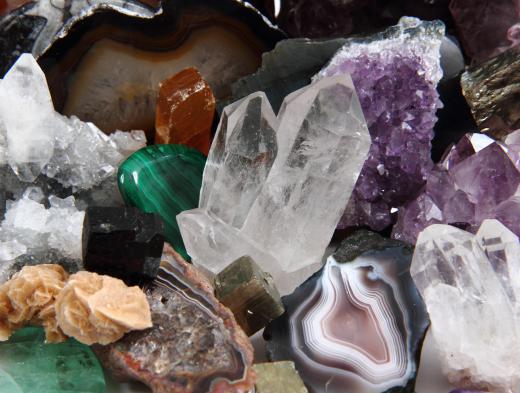What is Mineralogy?
Mineralogy is a branch of the earth sciences that is concerned with studying minerals and their physical and chemical properties. Within mineralogy there are also those who study how minerals are formed, where they are geographically located, as well as their potential uses. Like many sciences, mineralogy has its origins in several ancient civilizations, and it has been concerned primarily with the various methods of classification of minerals for most of its history. Modern-day mineralogy has been expanded by advances in other sciences, such as biology and chemistry, to shed even more light on the nature of the materials that form the earth we live on.
The ancient Greek philosopher Aristotle was one of the first people to theorize extensively about the origins and properties of minerals. His ideas were new and advanced for the time, but he and his contemporaries were largely incorrect in their assumptions. For example, it was a widely held belief in ancient Greece that the mineral asbestos was a kind of vegetable. Nevertheless, these ancient theories provided a starting point for the evolution of mineralogy as we have come to know it. It was not until the 16th century that mineralogy began to take a form that is recognizable to us, largely thanks to the work of German scientist Georgius Agricola.

The simplest way to study and classify minerals is to do so based on their physical attributes. These can include the microscopic structure of the mineral crystals, the way in which the mineral cleaves when struck, and its hardness. The Mohs scale of mineral hardness describes this particular property.
At the low end of the Mohs scale, the soft graphite used in pencils scores a one out of ten, whereas a diamond, the hardest earthly substance, scores a ten. It is interesting to note that both of these minerals are made of the same element, namely carbon. The differences in hardness and appearance are due only to the difference in the way the individual atoms are organized.

There are over 4,000 different types of minerals known to exist. Most of these are classified as rare or extremely rare, and only about 150 are present in large amounts. Another 50 to 100 are found only occasionally. Minerals not only comprise much of the earth's crust, but many are essential to good health. Many types also provide us with important building materials, and the components for some kinds of machinery.
AS FEATURED ON:
AS FEATURED ON:













Discussion Comments
I have always confused mineralogy with geology. After reading this definition of mineralogy, I see the difference. Geologists do not focus on the study of minerals; they study the materials and processes of the Earth and how those processes change the Earth over time.
Geologists study earthquakes, landslides, volcanic eruptions, and floods in order to better understand danger zones and to recommend that structures be built to guard against them. They map out communities to determine the need in certain areas for flood insurance.
Geologists work to find and produce natural gas, oil, and ground water. They locate rocks containing precious metals and plan mines and mining methods.
Have I got it right?
Post your comments